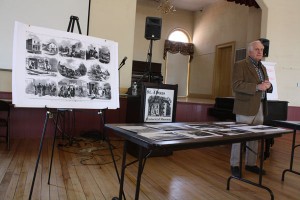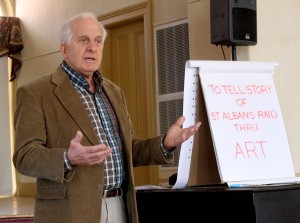
Richard Cummings speaks with area artists April 3 at the St. Albans Historical Museum. To his right are images from literary and news magazine Frank Leslie’s Illustrated Newspaper, showing a visual rendering of the St. Albans Raid, drawn just three days after it took place in October 1964. Local artists will recreate the raid again, this time for a 2014 calendar in conjunction with a raid reenactment.
Area artists have received a call to participate in next year’s St. Albans Raid 150th Anniversary Commemoration. The plan calls for a 2014 pictorial calendar, filled with local artists renderings, to tell the story of the northernmost action of the Civil War.
The commemoration will take place from Sept. 18-21 2014, with the calendar providing visuals from the Oct. 19, 1864 Confederate raid and the days leading up to it.
Richard Cummings is a member of the local raid anniversary planning committee, working with the St. Albans Historical Museum and others to prepare the events. Those will include two re-enactments in Taylor Park. On April 3 at the museum, Cummings explained to a handful of artists which images might serve best as calendar submissions.
Cummings said he hoped visitors attending the 2014 raid event — already proclaimed by the state as the Most Significant Civil War Event of 2014 in Vermont — would purchase calendars as souvenirs. The calendars, of course, also would be sold locally as keepsakes
On Oct. 19, 1864, Cummings told the artists, a lieutenant for the Confederacy, Bennett Young, and his band of raiders (estimated between 18 and 22 men) robbed three St. Albans banks – the First National Bank, the Franklin County Bank, and the St. Albans Bank. Students at what is now the historical museum on Church Street watched from the windows as hostages were held in the park and gunfire echoed below.
Chased out of town, the raiders tried to burn a bridge in Sheldon to slow Vermonters who were hot on their trail. The raiders were eventually captured in Canada and later were found to be war combatants and thus not subject to criminal laws.
The Confederates came to town days before the raid, staying at local hotels including the St. Albans House, the American House, and the Tremont, where City Hall now stands.
About $208,000 was taken in the raid, equal today to roughly $26 million. Much of the money was never returned to St. Albans.
Cummings noted that scenes depicting the hotels in which the raiders stayed, the robberies, the walks in Taylor Park that Young is believed to have taken with a local woman, and the lone casualty of the raid – a Manchester, N.H. contractor — at Mrs. Beattie’s Millinery Shop, are among artists’ options.
Artists are encouraged to focus on the people who were involved, including Young and Captain George Conger, a Union officer on leave who led the posse in pursuit of the Confederates.

Richard Cummings tells local artists the story of the St. Albans Raid, the northernmost event in the Civil War, Wednesday at the St. Albans Historical Museum. Illustrators will bring a revival to the raid by depicting its scenes for publication in a limited-edition calendar.
There a numerous events and people from which to draw ideas, said Cummings, including the prison guard who befriended the raiders and who appears in a photo with them.
Cummings urged artists to make sure they depicted clothing as Civil War era rather than Victorian, a common mistake. Women, for instance, did not wear bustles in the 1860s.
The re-enactments will take place in Taylor Park, Sept. 20 and 21, a Saturday and Sunday, in 2014. Facades of the 1800s buildings involved are being constructed.
Cummings hoped the calendar images would be in color, as most art showing the Civil War-era event is in black and white or sepia toned. He encouraged artists to show the lesser-seen side of the raid, including the inside of hotels, the raiders locking up bank workers in a vault, or a makeshift corral in Taylor Park.
“This stuff has never been done,” he said.
Others could show the humorous side of the raid. Cummings told artists gathered about one somewhat humorous happening after the raid. As the thieves were making their getaway, their horses grew tired in Sheldon. A horse was commandeered from an unsuspecting farmer there and the posse, hot on the trail, mistook the farmer for a raider.
Artists’ work can be any size, as long as the majority of the work can easily be shrunk to fit the 12 by 12-inch calendar space.
Some 2,500 calendars will be printed. Thirteen works of art will be chosen for the calendar. They will remain permanently on display at the museum, though prints will be made and sold, with profits likely shared by the museum and the artists.
Of the artists’ submissions, the top 20 will be on display during the community’s food and wine festival, an annual fall event.
For more information about the calendar, for which artists’ ideas are due in about two weeks, contact Richard Cummings at rick@vsbmetal.com.
By Jessie Forand
St. Albans Messenger Staff Writer



